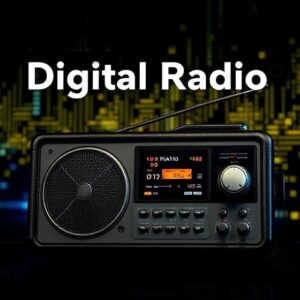What is Digital Radio?
Digital Radio is a type of radio broadcasting where radio signals are transmitted as digital data rather than the traditional analog signals. This means that the information, like music or voice, is converted into binary code (ones and zeros) before being broadcast.
Think of it like listening to music on your phone, but instead of downloading it, the music is streamed through radio waves in a digital format.

How Does Digital Radio Work?
- Analog vs Digital Signals:
- In analog radio, the sound is transmitted as continuous waves that can be affected by interference (like static, noise, or weak signals).
- In digital radio, the sound (or any broadcast content) is converted into binary code and transmitted as digital signals. These signals are much less prone to interference, making the sound clearer and more reliable.
- Transmission Process:
- A radio station sends out a digital signal using radio waves (the same way FM or AM radio works, but in a digital format).
- The radio receiver (your digital radio or a phone with a digital radio app) decodes the digital signal and converts it back into sound, like music, news, or talk shows.
- Digital Encoding and Compression:
- Digital radio uses a technique called compression to reduce the size of the audio files, so it’s easier to transmit over the airwaves. This allows for more stations and better quality.
- Compression means that the radio station can fit more stations or content into the same frequency range, and the audio quality can be high without using too much bandwidth.
Why is Digital Radio Better?
- Better Sound Quality:
- Digital radio provides clearer sound with less interference (like static). You can get crisp audio that sounds more like a CD or MP3 file rather than the fuzzy sound you might hear on analog radio.
- More Stations:
- Since digital radio uses compression and efficient broadcasting methods, more stations can fit into the same frequency range. This means you can listen to more channels (music, news, talk shows) on the same radio frequency.
- Extra Features:
- Digital radio often comes with additional features like:
- Song Information: The radio will show you the name of the song, artist, or show that’s playing.
- Better Reception: Digital radio tends to have more consistent and reliable reception. You don’t get the fading or static that analog radios sometimes have.
- Text & Data: Some digital radios can display other information, like weather updates, news headlines, or traffic reports.
- Digital radio often comes with additional features like:
- No Interference:
- Digital signals are less affected by static or interference, so you get a better listening experience. In analog radio, you might hear noise or fading if you’re too far from the station or in an area with lots of interference. With digital, the signal either works well or not at all, so there’s no in-between noise.
How Do You Listen to Digital Radio?
To listen to digital radio, you need a digital radio receiver, which could be:
- A dedicated digital radio device, often labeled as DAB (Digital Audio Broadcasting).
- Smartphones or tablets with digital radio apps (for online streaming) or built-in digital radio tuners.
- Car radios with built-in digital receivers.
- Internet-connected devices (like smart speakers) that stream digital radio stations over the internet.
Types of Digital Radio Systems
- DAB (Digital Audio Broadcasting):
- A popular form of digital radio in many parts of the world (like Europe and Australia). It uses a specific set of frequencies to broadcast digital signals.
- HD Radio:
- Used primarily in the United States. HD Radio is an upgrade to traditional AM and FM radio, allowing for digital broadcasting over the same frequencies.
- Internet Radio:
- While not “broadcasting” in the traditional sense, many radio stations stream their broadcasts over the internet, allowing you to listen to radio stations online or through apps on smartphones or smart speakers.
Advantages of Digital Radio:
- Improved Sound Quality: No static or fuzziness, with clearer sound.
- More Content: Digital radio can carry more stations and content, including multiple channels from a single broadcaster.
- Extra Information: Displays like song titles, artist names, or even text information like news and weather.
- Better Coverage: Less interference, so you can get consistent reception even in challenging areas.
In Summary:
- Digital Radio sends audio signals as digital data rather than analog waves, providing clearer sound, more stations, and extra features.
- It works by encoding audio into digital format, compressing it, and then transmitting it over radio waves.
- You need a digital radio receiver to listen, but you can also access digital stations through apps or internet-connected devices.
- Digital radio is great for people who want better sound quality, more station choices, and added information like song names or news updates.
In simple terms, digital radio is like listening to your favorite music or talk shows with clearer sound, no static, and more features than traditional radio!
Tags: analog vs digital, artist name display, audio compression, better reception, Binary Code, car radios, clear reception, compression, consistent signal, DAB+), data broadcasting, Digital Audio Broadcasting, digital broadcasting, digital channels, digital encoding, digital format, Digital Radio, digital radio apps, digital receiver, digital signals, digital tuner, extra features, frequency efficiency, HD Radio, improved audio quality, interference reduction, internet radio, more radio stations, news updates, online streaming, radio content, radio transmission, Radio Waves, signal clarity, Smart devices, smart speakers, smartphones, song information, Sound Quality, static-free audio, text display, traffic information, weather reports


